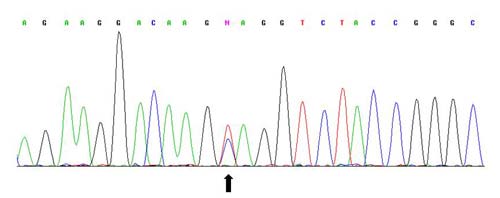Pseudohypoparathyroidism (PHP) represents a heterogenous group of the diseases whose common feature is the resistence to the parathyroid hormone. Based on the pathogenesis and the difference in phenotype of PHP it is divided into the 4 clinical units: PHP Ia, Ib, Ic and II. The common biochemical finding in all subgroups is increased PHP level, decreased or normal calcium level and increased levels of phosphates in blood.
PHP Ia is a disease characterized by the typical phenotype called Albright hereditary osteodystrophy (AHO) and by the multiple hormone resistance. Pseudopseudohypoparathyroidism (PPHP) is a term describing the patients with isolated AHO manifestations, however, with a quite normal calcium metabolism and normal PTH level.
The formation of PHP and PPHP is caused by the heterozygous inactivating mutation of the GNAS1 gene, encoding the α - subunit of the G protein (Gsα) associated with hormonal receptors. In the case of PHP and PPHP, bioactivity of the G protein α-subunit is reduced at 50 %.
GNAS1 is a complete locus on the long arm of chromosome 20 (20q13) encoding several gene products using 4 alternative first exons which are followed by the common exons 2-13. In this locus there is observed a complicated system of imprinting. One of the main gene product of this locus is a stimulatory G protein α - subunit (Gsα) associated with hormonal receptors.
Inactivating heterozygous mutations in patients with PHP were found almost in all 13 exons coding Gsα. In most cases it concerns nonsense and missence mutations. Further, there were identified deletions and insertions which lead to the alternative splicing of the primary transcript or cause the premature termination of translation. A various clinical phenotype inactivating the heterogenous mutations, such as PHP Ia or PPHP, is determined by the imprinting of the GNAS1 gene. In a number of endocrine tissues there is physiologically imprinted parental allele of this gene. Hormonal resistence accompanying AHO in the case of PHP Ia is caused by an inactivating mutation on a maternal allele.
Examination
GNAS1 gene screening is the only way to the definitive confirmation of PHP Ia and PPHP diagnosis. In our laboratory, we perform the mutation analysis of all coding sequences of the GNAS gene including exon - intron joints using PCR amplification and direct sequencing.
Clinical sensitivity:
The heterozygous inactivating mutations in the gene GNAS1 is responsible for the creation of PHP Ia and PPHP.
Sequence analysis of the coding exons and exon-intron connections detects approximately 85% of mutations in the gene GNAS1 listed in a publicly available version of the mutation database HGMD (The Human Gene Mutation Database).
MLPA (Multiple-Ligation Probe Amplification) analysis of mutations in a large-scale (amplification / deletion) and the aberrant methylation detects approximately 9% of alterations in the gene GNAS1 listed in a publicly available version of the mutation database HGMD.
Analytical sensitivity and specificity of the sequencing: 99%.
Limitations:
Mutations deep in the introns and regulatory sequences are not detected. Rare polymorphisms in the location of primers or probes annealing may cause a diagnostic error. Given the highly GC-rich region of the first exon of the gene GNAS1 only a portion is sequenced- and it is 74%. In this unsequenced region (i.e. at positions 1-20 and 124-139 of the cDNA and the adjacent exon-intron junction), according to a publicly available version of the mutation database HGMD 8% of causal mutations occur.
References
- Mantovani G, Romoli R, Weber G, Brunelli V, De Menis E, Beccio S, Beck-Peccoz P, Spada A. Mutational analysis of GNAS1 in patients with pseudohypoparathyroidism: identification of two novel mutations.J Clin Endocrinol Metab. 2000 Nov;85(11):4243-8.
- Kacerovska D, Nemcova J, Pomahacova R, Michal M, Kazakov DV.Cutaneous and superficial soft tissue lesions associated with Albright hereditary osteodystrophy: clinicopathological and molecular genetic study of 4 cases, including a novel mutation of the GNAS gene.Am J Dermatopathol. 2008 Oct;30(5):417-24.

